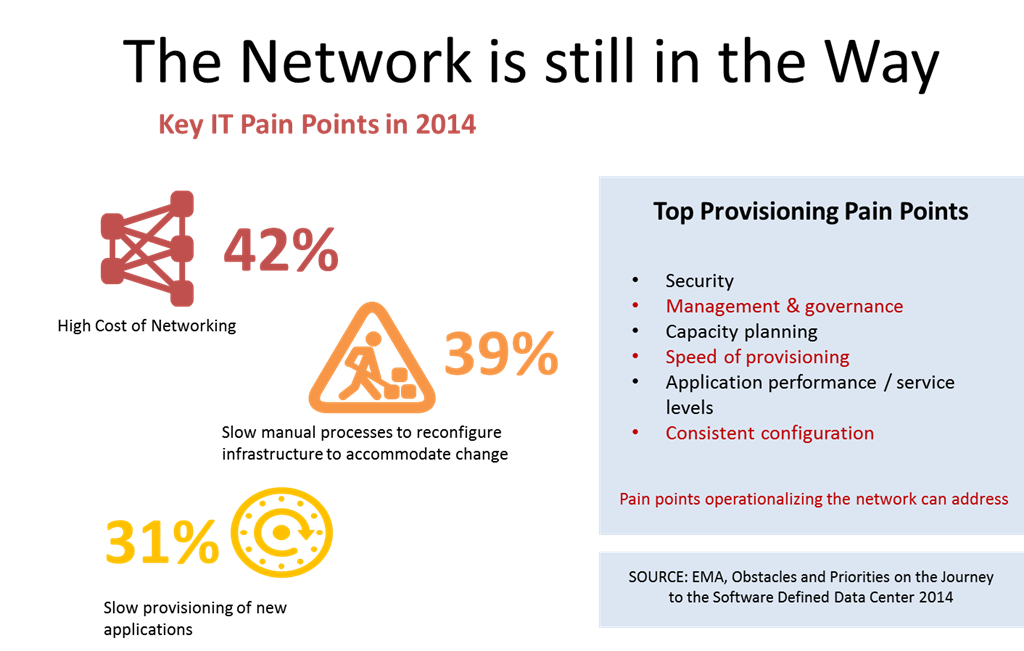Die Starrheit der Organisation, nicht die Hardware, verzögert die App-Bereitstellung
Die Vertiefung der Kluft zwischen traditioneller IT und einer agileren, DevOps-gesteuerten IT führt zur Entstehung einer im Wesentlichen zweistufigen Rechenzentrumsarchitektur. Für aufmerksame Beobachter dürfte das keine Überraschung sein. Seit Jahren werde ich mit Fragen von Betriebsmitarbeitern und Entwicklern überschwemmt, die schneller und häufiger vorankommen wollten, aber nicht durch die Starrheit der Hardware im Kernnetzwerk, sondern durch die Prozesse behindert wurden, die manuelle Genehmigungen und Prozesse zur Implementierung von Änderungen erfordern.

Die Reibungen zwischen denjenigen, die für die Aufrechterhaltung einer sicheren, stabilen und schnellen Datenübertragung in und aus dem Rechenzentrum zuständig sind, und denjenigen, die dafür verantwortlich sind, die Applications und Funktionen, die als Katalysatoren für das Unternehmenswachstum gelten, jetzt auf den Markt zu bringen, führen naturgemäß zu vielen hitzigen Worten, Schuldzuweisungen und schlechten Gefühlen.
Viele schieben die Schuld gerne auf „Boxen“. Diese veralteten Hardwarekomponenten im Netzwerk sind zwar in die Jahre gekommen, stellen aber die kritischen Dienste bereit, die Applications benötigen, um skalierbar und sicher zu sein, sind aber einfach „im Weg“. Aber die Realität ist, dass diese Boxer selbst keine Schuld tragen. Fast alle verfügen heute über eine API, die es jedem mit Zugriff auf curl und praktischen HTTP-Kenntnissen ermöglicht, die Dienste, die mit der Bereitstellung jeder Application einhergehen, zu konfigurieren, zu verwalten und anderweitig zu manipulieren. Viele dieser „Boxen“ sind selbst virtualisiert und dienen dazu, dieselbe Art virtueller Erfahrung zu bieten wie tiefer im Rechenzentrum.
Sie stellen kaum Hindernisse auf der Schnellstraße dar, die das Konzept der kontinuierlichen Bereitstellung darstellt.
Es ist vielmehr die Starrheit der Organisationen bzw. der Unternehmenskultur, die - wie DevOps-Befürworter gerne sagen - diese Reibung verursacht und die Application verlangsamt. Da in der Produktion Stabilität und Sicherheit gewährleistet werden müssen, die in der volatileren Umgebung der App-Entwicklung nicht unbedingt gegeben sind, besteht eine geringere Toleranz gegenüber Fehlern und den dadurch unvermeidlichen Geschäftsunterbrechungen.
Das ist nicht unbedingt eine schlechte Sache. Das Kernnetzwerk muss auf jeden Fall ein hohes Maß an Verfügbarkeit aufrechterhalten, nicht nur um den Zugriff auf Applications im Rechenzentrum sicherzustellen, sondern auch für diejenigen Benutzer darin, die bei ihrer Arbeit auf öffentliche SaaS-Lösungen angewiesen sind.
Unternehmen müssen allerdings Einschränkungen lockern, um die Anforderungen beider Architekturebenen im modernen Rechenzentrum besser in Einklang zu bringen. App-Bereitstellungen müssen schneller und häufiger erfolgen. Um das zu erreichen, müssen sich die Unternehmen ihre aktuellen Prozesse genau ansehen, die mit ziemlicher Sicherheit starrer und unnachgiebiger sind als die von ihnen gesteuerten Boxen. IT-Betriebsabläufe sind für Unternehmen heute ebenso wichtig wie die Geschäftsprozesse selbst. Unternehmensleiter wissen, dass sie untersucht, ausgewertet, dokumentiert, automatisiert und verbessert werden müssen, um Effizienzsteigerungen und eine bessere Geschäftsleistung zu erzielen. Und was noch wichtiger ist: Sie müssen flexibel genug sein, um bei Bedarf geändert werden zu können. Dafür müssen Unternehmen diese Prozesse allerdings verstehen und bereit sein, sie kritisch zu prüfen und auf Ineffizienzen und Engpässe zu achten.
In einem AIIM Industry Watch Report aus dem Jahr 2016 mit dem Titel „ Informationsmanagement – Stand der Branche 2016 “ gaben 55 Prozent der Befragten an, dass Business Process Management (BPM) für ihr Unternehmen wichtig (38 %) oder unerlässlich (17 %) sei.
Beim Einsatz von Technologie zur Prozessoptimierung konnten die Unternehmen auf ganzer Linie Verbesserungen verzeichnen:
❶ Ein Drittel der Organisationen konnte eine Verkürzung der Prüf- und Genehmigungszyklen verzeichnen und 62 % geben an, dass sie durch eine bessere Weiterleitung an und zwischen einzelnen Personen Vorteile erlangt haben. 42 % der Befragten sind der Ansicht, dass sich die Vorteile aus einer größeren Flexibilität der Organisation und einer besseren Weiterleitung der Prozesse ergeben.
❷ Die schnellere Abwicklung geschäftskritischer Aktivitäten hat für 53 % der Befragten den größten Nutzen gebracht. 45 % geben an, dass der größte Nutzen darin besteht, weniger Fehler und Ausnahmen zu verarbeiten.
❸ Für 41 % der Befragten wurde die Investition innerhalb eines Jahres amortisiert und 17 % gaben an, dass sich die Investition innerhalb von 6 Monaten rentierte. Bei 25 % lag der ROI innerhalb von 18 Monaten.
Die IT verwendet den Begriff „Orchestrierung“ häufig, diskutiert jedoch selten, in welcher Beziehung er zum Prozess steht. Echte Verbesserungen lassen sich erzielen, wenn durch Orchestrierung die Betriebsabläufe automatisiert werden, die die Bereitstellungen steuern. Durch das Aufdecken von Verschwendung und Lücken im Wertstrom sowie durch die Beseitigung von Wartezeiten, unnötigen Genehmigungen und Redundanzen können Unternehmen die gleiche Geschwindigkeits- und Agilitätssteigerung erzielen, die sie auf der Geschäftsprozessseite erlebt haben.
Wir können es DevOps oder Operational Process Management (OPM) nennen, aber in Wirklichkeit sind die beiden eng miteinander verwandt. Unternehmen müssen bei ihren operativen IT-Prozessen dieselben Anpassungen vornehmen wie bei ihren Geschäftsprozessen, um eine höhere Agilität und Geschwindigkeit bei der Bereitstellung von Anwendungen zu erreichen, ohne dabei Stabilität und Sicherheit zu beeinträchtigen.
Und hat wenig damit zu tun, ob sich Boxen im Rechenzentrum befinden oder nicht.
